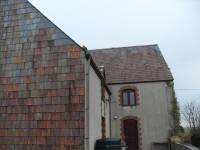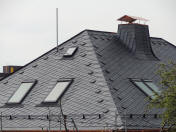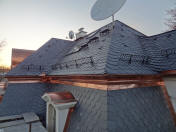| As the
horsemeat crisis was at its peak recently, I happened to be walking down the
ready meal aisle of my local Tesco. It struck me how much trust we give to
the people who sell our food. |
|
We need to trust our supermarkets. They, in
turn, need to trust their suppliers. They need to trust their manufacturers,
and so on.
|
| When
this chain of assurance is broken, how can we really be sure of what is on
our plates? Indeed, millions of consumers were told during February and
March that, in place of the succulent beef shown on the boxes, they had
actually been eating horse. |
|
Looking at all those glossy photographs on packs of “beef” lasagnes, cottage
pies and burgers stacked up in the supermarket’s fridges told me something
else: appearance is simply not enough. |
| This is so true in
our industry too. A roof made from slate that looked really good when it was
installed, can fail within just a few years. And remember: “failure” ranges
from ugly rusting that spoils the appearance of a building; to catastrophic
holing of slates, or a complete discolouration and disintegration of the
slate. This leads to the roof needing to be totally restripped and replaced. |
 |
| It’s
an unpleasant and expensive way to find out that your product isn’t what you
thought it was. |
| We
must have good traceability because slate gets sourced from a quarry. A
quarry typically covers a large area, across which you find rock of varying
grades. You can take both ‘good’ and ‘bad’ slates from the same seam of
rock. |
| This
is completely normal. And under properly controlled conditions it allows
companies to offer a product range for projects of a range of budgets and
specifications. |
| But
you get a big problem when a supplier fails to identify each grade clearly.
This might happen deliberately or carelessly, but the upshot is the same:
different specifications that are sold under the same brand name. |
| Qualifying for the
ubiquitous ‘CE’ mark is easy. A quarry simply submits rock samples of its
own choosing and sends them to be tested to the BS EN 12326 standard. If the
samples don’t represent the quarry as a whole – unintentionally or otherwise
– it can easily give a misleading result. A quarry given the highest
possible classification of A1-T1-S1 could in theory be the source of slate
that is of significantly lower quality. |
 |
|
Certain regions deliver consistently high quality slate. Take the La Cabrera
area of Spain from where we source Del Carmen and Matacouta, two of the
world’s best quality slates. All of our slates are traceable to source, with
Del Carmen also offering barcoded tracking and unique pallet numbers - one
of the reasons it is tested to the world-leading slate standard NF 228, and
passes with flying colours. |
| If you
can be absolutely sure your slate comes from such an area, it’s a guarantee
of resilience, durability and overall quality. But in variable areas, slates
containing both reactive and non-reactive pyrite are being sourced. If the
minimum quantity slate from one of these quarries has achieved the A1-T1-S1
classification, there is absolutely nothing to stop a quarry from achieving
and marking all their products with it. You can see how this can lead to
roof failures. |
| A
reputable quarry such as Sarria, in Spain, wouldn’t risk damaging its
long-term reputation of its stone with misleading markings, but it does
happen. This can be exploited further along the supply chain, when customers
offer their clients poorer grades of slate in place of the higher specs they
actually need. |
| Traceability must
be part of specification process; it’s simply not an optional extra. If you
can guarantee where your slate comes from, it guarantees the performance and
lifespan of the projects in which it is used. And ultimately you have an
assurance that messy, reputation-damaging roof failures will not occur.
|
 |
| Why ignore this in
favour of choosing materials based purely on their price? It is a false
economy, and the long-term costs, dwarf any short-term savings – a truth
that the food industry is experiencing first hand. |
| If you
wonder what I chose for dinner that day, I actually left the supermarket
empty handed - I’d lost my appetite. Traceability makes, if you like, the
difference between getting a fillet steak or ending up with horse meat on
our plates. |